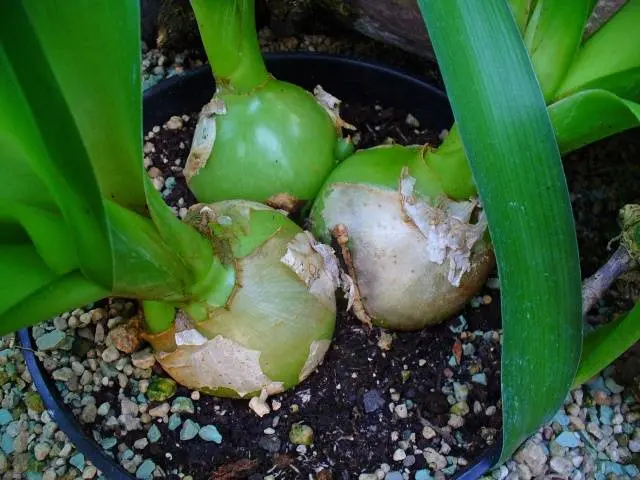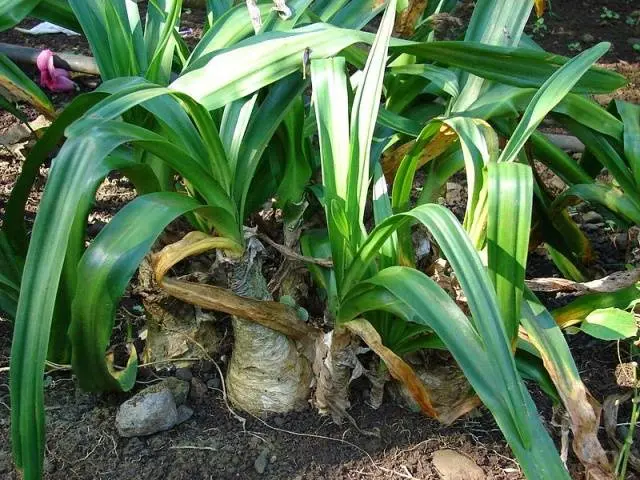Contents
Indian onions are grown in apartments and household plots. The flower has decorative properties, and the juice from its shoots is an effective external remedy.
Description
Indian onion is a perennial indoor flower, a representative of the Asparagus family. The name is associated with the similarity of the burning juice of the flower with Indian spices. The plant is also known as the birdman, ornithogalum, Chinese, Mongolian and squill.
In nature, the flower is common in the subtropics and temperate zones of the Mediterranean, Asia, Africa, and America.
The plant reaches a height of 30-80 cm. The bulb is ovoid, 8-9 cm in size, covered with dense scales up to 5 cm in size. The leaves are basal, linear. There is a whitish vein in the middle of the leaf plate.
The flowers are yellowish or white, odorless, collected in corymbose or racemose inflorescences. After flowering, a fruit is formed in the form of a box with seeds.
Indian onions are grown in greenhouses, residential and public buildings. The flower does not need special care, but grows more intensively in good sunlight. In summer, the plant can be transplanted into open ground.
In folk medicine, the plant has an external use. It is added to ointments, water and alcohol tinctures.
The plant has disinfectant properties, reduces inflammation and anesthetizes. Means based on it help with fractures, hematomas, radiculitis, osteochondrosis, varicose veins, accelerate tissue regeneration, relieve itching.
Photo of Indian onion:

Before using Indian onions, it is better to consult a doctor. Often there is an individual intolerance to the juice of the plant. When working with a flower, you need to protect the skin from exposure to its juice. When interacting with poisonous parts of the plant, rinse the contact points with water.
Methods of reproduction
Indian onions are propagated by babies or seeds. On an adult plant, small bulbs appear. They develop rapidly and separate from the main bulb. Babies release their own roots and take root in the soil.
Young bulbs are carefully detached from the mother plant. They are planted in the ground or stored in a dry place. Children are placed in a container, pour peat and provide good ventilation. Under such conditions, the bulb remains viable for 2 years. Planting material tolerates transportation well.
To obtain planting material, the inflorescences are pollinated by hand. If the flower is in open ground, then pollination is carried out by insects. Seeds are harvested in autumn and stored until spring. To speed up germination, the seeds are kept in the refrigerator for 4-5 months.
In the spring, fertile soil is prepared and the seeds are planted to a depth of 1,5 cm. A layer of earth is poured on top and the plantings are watered abundantly.
The period of germination of a flower from seeds is up to 8 months. The containers are stored in a warm, ventilated place, the soil is regularly moistened. When the seedlings have 3-4 leaves, they are seated in separate containers.
After the formation of the bulb, the plant begins to develop intensively. The bulb is not buried, it is partially left above the soil surface.

Cultivation at home
Indian onions are adapted to room conditions. Flower care is simple and involves a minimum of operations. The plant needs moderate watering, responds well to top dressing, withstands transplantation.
Soil preparation
Substrate is prepared for planting. To do this, mix river sand, sheet and sod land in a ratio of 2: 1: 1. Instead of soddy soil, it is allowed to use humus.
The plant is transplanted into a clay or ceramic pot. Such containers are quite heavy and do not tip over under a powerful plant. The walls of the pots pass air well, and excess moisture evaporates faster.
In addition to the holes in the pot itself, you need to provide a drainage layer. Expanded clay or fragments of bricks are used as drainage. They are placed at the bottom of the container.
Care scheme
When grown at home, Indian onions need regular watering. Moisture is applied after the top soil layer has dried. In July, after the leaves fall, the intensity of watering is reduced. Plants tolerate drought for a period of 2-3 months.
The flower prefers bright lighting. At home, the flower is determined by the south, west or east window.
The flower tolerates heat better than cold. Room conditions are comfortable for the plant. It is important not to allow the temperature to fall below +12 °C. The plant is not left in a draft or a cold windowsill.

If the air in the apartment is dry, the shoots of the flower turn yellow. The plant is sprayed with warm water from a spray bottle. Air humidity must be increased in summer, as well as in winter in a heated room.
Spraying is done in the early morning. If the drops remain on the leaves, then the plant will get burned when exposed to sunlight.
The root system needs access to oxygen. The soil in the pot is regularly loosened. It is best to loosen after watering. Dust is removed from the leaves of the flower to improve the process of photosynthesis.
Since the bulb of the plant is actively developing, it needs a constant supply of nutrients. The soil does not contain all the micro and macro elements, so their lack is compensated by top dressing.
Types of fertilizers for growing Indian onions at home:
- complex fertilizer for indoor plants;
- infusion of woody water containing 1 tbsp. l. substances per 1 liter of water;
- mullein solution in a ratio of 1:15;
- weak solution of potassium permanganate.
Top dressing is carried out from March to August. During this period, the plant increases its green mass and produces inflorescences. Solutions are applied once a month by watering in the morning or evening. It is best to alternate the use of organic matter with mineral supplements.
Transfer
Every 2 years, you need to change the soil and the container in which Indian onions grow. Over time, the plant increases the root system and the aerial part, so it is transplanted into a larger pot.
A drainage layer of expanded clay is placed at the bottom of the tank, then the prepared soil is poured. For transplantation, they take soil of the same composition as when propagating a flower.
The bulb is half buried in the soil, the rest should rise above the ground. The plant is watered abundantly.

Outdoor cultivation
In a warm climate, if the air temperature does not drop below +12 ° C, Indian onions are planted in an open area.
The flower is grown in a garden bed illuminated by the sun. The plant feels good in partial shade under shrubs or trees, it is planted in neutral soil, humus or compost is added. During the season, the flower is moderately watered.
In the open ground, more babies appear on the bulb for reproduction. There is also abundant and long flowering.
In autumn, the flower is dug up and stored at room conditions. In winter, it is grown as a houseplant, periodically watered and protected from exposure to cold air.
The plant can be provided with a dormant period. Then it is stored in a dark place, periodically the soil is sprayed. After transplanting into the ground in the spring, flower care is resumed. The flower is watered abundantly, which stimulates its awakening.
Photo of an Indian onion growing in the open air:

Conclusion
Indian onion is an unpretentious plant with beneficial properties. Shoots and bulbs are suitable only for external use, their juice is poisonous. When growing, increased attention is paid to watering and top dressing. The flower is grown at home, in a warm climate, landing in the ground is allowed.










